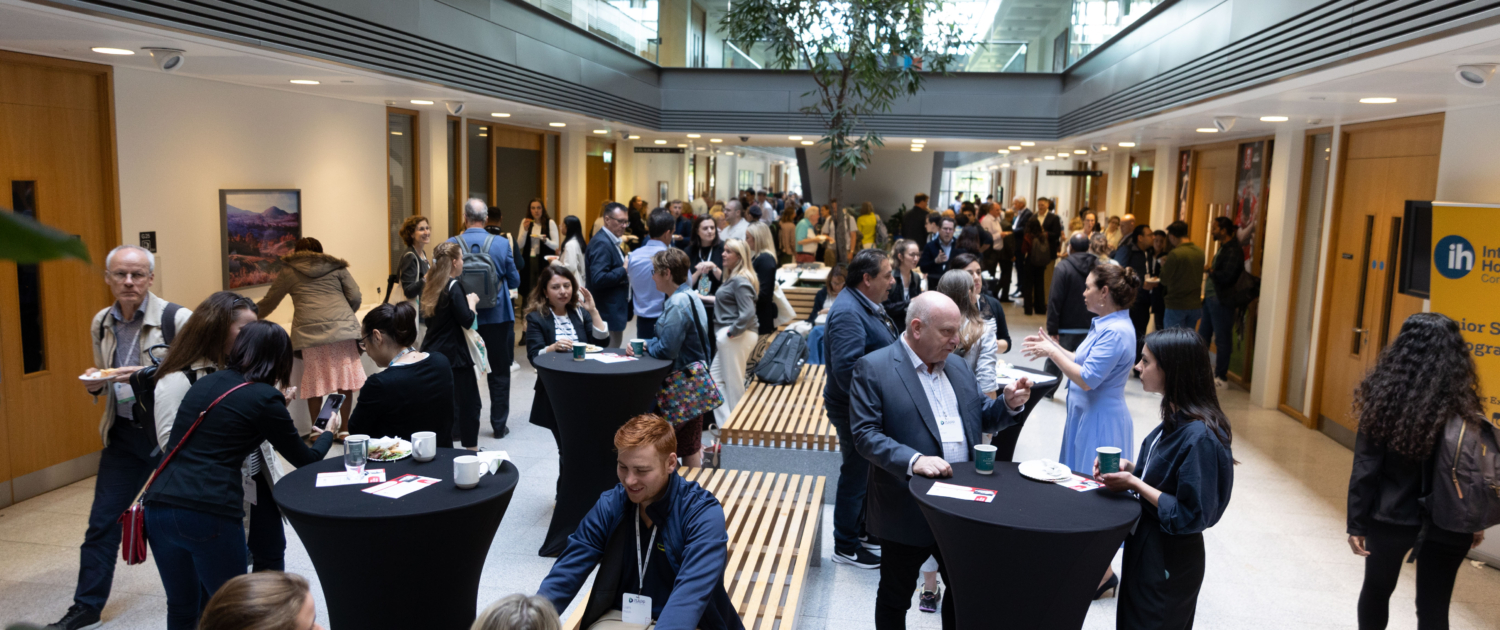The premeeting program on the morning of Tuesday 15th July is an opportunity for ISAPP industry members to gather together and share, learn and connect. The program is organised by Industry Advisory Committee (IAC) representatives to feature topics of member interest and provides opportunities to exchange with early career researchers from the ISAPP Students and Fellows Association (SFA) on topics of innovation. It begins with a member networking breakfast and concludes with updates and dialogue with the ISAPP Board of Directors on current and future ISAPP activities.
07:15 – 08:15 IAC member networking breakfast and meeting registration
08:30 – 09:30 IAC featured plenary session
09:30 – 10:00 Morning tea break
10:00 – 11:30 Innovation Workshops – IAC and Students and Fellows Association (SFA).
-
Non-Gut Microbiomes, chaired by Shalome Bassett (Fonterra)
-
Mechanisms of Action – From Microbe to Mechanism, chaired by Jessica Van Harsselaar (Beneo)
-
The Promise and Potential of Next-Generation Probiotics (NGPs), chaired by Patricia Sanz (University of Reading)
-
Microbial Consortia, chaired by Dave Hourigan (University College Cork)
Click on the workshop titles to view descriptions
Workshop 1: Non-gut microbiomes
Chair: Shalome Bassett (Fonterra)
While traditional biotic research has primarily focused on the gut microbiome and its role in overall health and wellbeing, the body is also host to a variety of other microbiomes that likewise play important roles in health and disease and are fast-becoming important targets for biotic interventions and novel solutions. This session will focus on biotic applications for the skin, oral, vaginal, and respiratory microbiomes, emphasizing innovations for biotics beyond traditional gut-focused applications.
Discussion Questions:
a. What is known or remains unknown for each of these microbiomes? What model systems are used and how could these be improved? Is there a role for bioinformatics?
b. What problems still need to be solved and what science do we think needs to be done to address these?
c. Where are the opportunities and the pitfalls for biotic solutions? Also consider regulatory and product application areas
d. What is the overlap/interaction between the gut microbiome and these other microbiomes? How does this need to be factored into our science? How would an oral biotic solution impact these areas over other applications such as suppositories, topical applications, lozenges etc. And what would the effect of other modes of application have on the gut microbiome? Do we need to consider this?
e. Is there room for prebiotic solutions in this space?
f. What important considerations are required for RCTs? E.g. postbiotic vs probiotic, biomarkers etc. (also consider regulatory/safety requirements)
Possible outcomes: an ISAPP infographic on non-gut microbiomes and/or a published review article. It may also prompt a webinar topic such as oral health or skin health.
Workshop 2: Mechanisms of Action – From Microbe to Mechanism
Chair: Jessica Van Harsselaar (Beneo)
Biotic interventions—including probiotics, prebiotics, and postbiotics—operate through a variety of mechanisms that influence microbial communities, host responses, and systemic health. While these categories have distinct definitions, they also share common pathways in how they modulate the gut ecosystem and impact physiological functions.
This session will explore the core principles underlying the mechanisms of action of biotics. We will discuss the key factors that drive biotic efficacy, including microbial viability, metabolite production, and host-microbe interactions. The discussion will help refine our understanding of how biotics exert their effects and identify gaps in current knowledge.
Discussion Questions:
a. What are the shared and distinct mechanisms of action across probiotics, prebiotics, and postbiotics?
b. How do biotics exert systemic effects beyond the gut?
- What are the key pathways linking microbial activity to host metabolism, immunity, and neurological functions?
- How do we differentiate between direct microbial effects and indirect host-mediated responses?
c. What are the most critical evidence gaps in biotic mechanisms, and how can they be addressed?
- What level of mechanistic understanding is required for regulatory and consumer acceptance?
Outcomes: May include follow-up workshop and / or infographic
Workshop 3: The Promise and Potential of Next-Generation Probiotics (NGPs)
Chair: Patricia Sanz (University of Reading)
Next-Generation Probiotics (NGPs) are emerging as a transformative frontier in the field of biotics. These are microbial species that fulfill the general criteria for probiotics (e.g., conferring a health benefit on the host when administered in adequate amounts) but are often newly identified, lack a documented history of safe use in foods or supplements, and may include genetically engineered strains designed for targeted functions.
This workshop aims to spark dialogue around the scientific, regulatory, and translational aspects of NGPs, particularly in relation to human health challenges and the future of personalised interventions.
a. We will begin by exploring the following core questions: What defines a “next-generation probiotic” and how do engineered microbes fit into this category?
-
- Should NGPs be limited to novel, naturally occurring commensals (e.g., Akkermansia muciniphila, Faecalibacterium prausnitzii), or do genetically modified strains also qualify?
- What are the minimum criteria to be met (e.g., safety, mechanistic insight, clinical efficacy)?
- How can we distinguish between “emerging” probiotics and true “next-generation” innovations
b. Key challenges in human health or disease that next-gen probiotics might have the potential to solve:
-
- Which unmet medical needs or disease mechanisms might NGPs address better than traditional probiotics?
- · Can NGPs serve as adjuncts or alternatives to current pharmaceutical treatments (e.g., in metabolic disorders, IBD, mental health)?
- · What kind of evidence would be needed to support such claims?
If there’s time for further discussion, we will also explore the following questions:
c. How do you see next-generation probiotics shaping the future of personalised medicine?
-
- Could specific microbial strains be matched to host genetics, immune profiles, or microbiome signatures?
d. How might advances in microbiome diagnostics and AI-based modelling help personalise NGP use?Are there any specific disease areas where next-gen probiotics could become a first-line therapy in the next decade?
-
- Considering current clinical pipelines and recent translational advances, where do you see the most realistic near-term applications (e.g., gut-brain axis, oncology, allergy)?
- Could regulatory innovation (e.g., Live Biotherapeutic Products pathways) accelerate this timeline?
- In light of the recent ISAPP blog post on personalized medicine, how might NGPs bridge the gap between evidence-based science and real-world applications?
References:
- https://isappscience.org/the-promise-of-personalized-medicine/
- Al-Fakhrany OM, Elekhnawy E. Next-generation probiotics: the upcoming biotherapeutics. Mol Biol Rep. 2024 Apr 15;51(1):505. doi: 10.1007/s11033-024-09398-5. PMID: 38619680; PMCID: PMC11018693.
Potential outputs: Infographic and/or ISAPP Science Blog
Workshop 4: Microbial Consortia
Chair: Dave Hourigan (University College Cork)
This session will explore commensal bacterial consortia and how their ecological dynamics can be harnessed to enhance microbiome modulation. The workshop will explore the composition of defined microbial consortia, interactions between members and nutritional dependencies. Well-defined commensal bacterial consortia have the potential to address the limitations of current probiotics and overcome challenges associated with personalised interventions.
Context:
Microbial consortia represent a promising approach to overcoming the limitations of personalized medicine and enhancing therapeutic outcomes. By focusing on the ecological suitability and community dynamics of multi-strain consortia, we can better understand how these communities interact within complex environments, such as the human microbiome. The principle behind commensal bacterial consortia (CBC) is the reverse engineering of a faecal microbiota transplant (FMT), (or other microbiota) to only transfer known microbes with known genotypes to increase efficacy and eliminate unwanted/unknown transfer.
Key Concepts:
- Microbiome as a Community: The microbiome is not just a collection of individual microorganisms, but a dynamic community where inter-bacterial interactions, auxotrophic dependencies, cross-feeding and community composition all play crucial roles in maintaining balance and stability.
- The Role of Consortia: Microbial consortia, composed of multiple strains working synergistically, hold the potential to modulate the microbiome more effectively than single strains. These communities can be engineered for specific therapeutic purposes, offering a promising strategy to personalize and optimize treatments. Think of a Lego-like plug-and-play approach for defining CBC.
Discussion Questions:
- What is a commensal consortia? Can we define it?
- Colonisation comparison for CBC vs single strain intervention (SSI)?
- How do priority effects influence SSI vs CBC?
- Do bacterial consortia “divide the labour” to confer a benefit when being introduced in comparison to SSI? Do initial interactions in the consortia prime competition?
- Can we strategically design CBC that integrate with precision nutrition? (evidence at the moment looks like resource depletion is a key driver of decolonisation).
- Are CBC financially attractive for industry if consortia can overcome the hurdles of personalised interventions?
Output aims of the discussion group: A perspective-type publication looking forward towards the use of consortia and/or blog post.
Inspired and derived from:
Furuichi, M., Kawaguchi, T., Pust, MM. et al. Commensal consortia decolonize Enterobacteriaceae via ecological control. Nature 633, 878–886 (2024). https://doi.org/10.1038/s41586-024-07960-6
“Together, these results suggest that the F18 strains function cooperatively to suppress Klebsiella by competitively reducing gluconate availability.” Is it possible that what looks to be co-operation is a localised competition where the sum of the consortia confers the benefit because its introducing “active” competition ?
Isaac, S., Flor-Duro, A., Carruana, G. et al. Microbiome-mediated fructose depletion restricts murine gut colonization by vancomycin-resistant Enterococcus. Nat Commun 13, 7718 (2022). https://doi.org/10.1038/s41467-022-35380-5
van der Lelie, D., Oka, A., Taghavi, S. et al. Rationally designed bacterial consortia to treat chronic immune-mediated colitis and restore intestinal homeostasis. Nat Commun 12, 3105 (2021). https://doi.org/10.1038/s41467-021-23460-x
REBYOTATM (from Ferring and Rebiotix) and VOWST (formerly SER-109, from Seres) i.e.





